
Today I’m going to show you how to study for your math tests.
After teaching math for over 15 years, I’ve seen what works best and what methods to avoid.
So if you’re curious how to improve your grades and reduce your math anxiety, then you’re going to love these strategies!
- Table Of Contents
- 1. Who Else Wants Better Grades? Then Avoid These Bad Study Habits
- 2. Here’s a Method That Is Helping Students Get Better Grades On Their Math Tests (Pre-Knowledge)
- 3. Active Participation Is The Secret Sauce For Great Recall
- 4. Reduce Math Anxiety The Easy Way (Practice Problems)
- 5. Squash Procrastination With Habit (Study Daily)
- 6. Jolly Rancher Your Way To A’s
- 7. How Does Your Study Environment Affect Your Test Scores? Or Does It?
- 8. Interesting Ways To Teach Others, Even If You’re Shy
- 9. Let Me Show You The Power Of Study Groups
- 10. Learn While Dreaming (Yes, It Does Work)
- 11. Memorization Is Hard, But It Improves Your Grade, Here’s Why…
- 12. Make A Study Sheet You Can Be Proud Of
- 13. Here’s The Easiest Way To Remember Stuff (Mnemonic Devices)
- 14. Mr. Calculator (Friend Or Foe?)
- 15. Embrace Different Learning Styles To Get Unstuck
- 16. What Everyone Ought To Know About Asking For Help
- 17. GRIT
1. Who Else Wants Better Grades? Then Avoid These Bad Study Habits
When you’re studying for a math test you want to work smarter not harder. Therefore, there are some things you want to avoid when you are getting ready for a math exam.
Cramming
Don’t wait until the last minute. Cramming doesn’t work in the long run, however studying a little bit each night will help you to remember more and remember longer. I’ll have more to say on this later.

Cramming For A Math Test
Rereading your textbook only gives you the illusion of knowledge
Don’t just read. Simply reading over your notes or textbook is not enough to fully comprehend the material.
You need to actively engage with the notes and textbook by working examples. In fact, you will find that the example problems in many textbooks are missing steps! Meaning, the text will leave out algebraic steps like simplifying an expression or reducing fractions. So it’s up to you to put the missing pieces together. And sadly it’s in these missing steps that hold the key to mastering many mathematics techniques, leaving many students frustrated as to “how in the world did they get that answer?”
Consequently, you need to work the examples on your own so you know how to arrive at the correct answer.
Highlighting & underlining should be used sparingly
Don’t rely on highlighting. While highlighting is a great and effective study tool, it shouldn’t be your first choice as it’s far too passive. Write your own notes and examples, and only highlight as a way of connecting ideas or color coding or drawing your attention to a particular section of your textbook or notes. Remember, highlighting is a complement to your studying, and should never take the place of note-taking.
Only looking at the solution
Don’t just look at the solution and assume you know how to solve the problem. This is one of the greatest errors you can make when studying.
You really need to do the problem, step-by-step and think through the process of how to arrive at the correct solution. Just flipping to the back of the book and glancing at the answer and saying “Oh yeah, I know how to do that,” isn’t enough. Saying you can solve a problem, and actually solving the problem are two different things, and when studying for a math test, you need to solve not just look.
2. Here’s a Method That Is Helping Students Get Better Grades On Their Math Tests (Pre-Knowledge)
There’s a sense of power and excitement that seems to wash over us when we understand something for the first time. It’s the big “a-ha” moment, and it feels great!
For some, it may feel like those a-ha moments are few and far between when it comes to math – but they don’t have to be. It all comes down to pre-knowledge.
The trick is to change your study habits so that you’re getting ahead (offense), rather than continually reviewing (defense). Now there is a time and a place for both of these concepts, and they are both equally important in your overall success in any math class, but to set yourself apart and make your math journey easier, there’s nothing better than a good offense, and that’s pre-knowledge.
Think about it; all major athletes come prepared to play. They don’t wait until game day to figure out the rules and skills necessary to compete. They’ve practiced and are ready to show off. Treat each math class as a game day – come prepared.
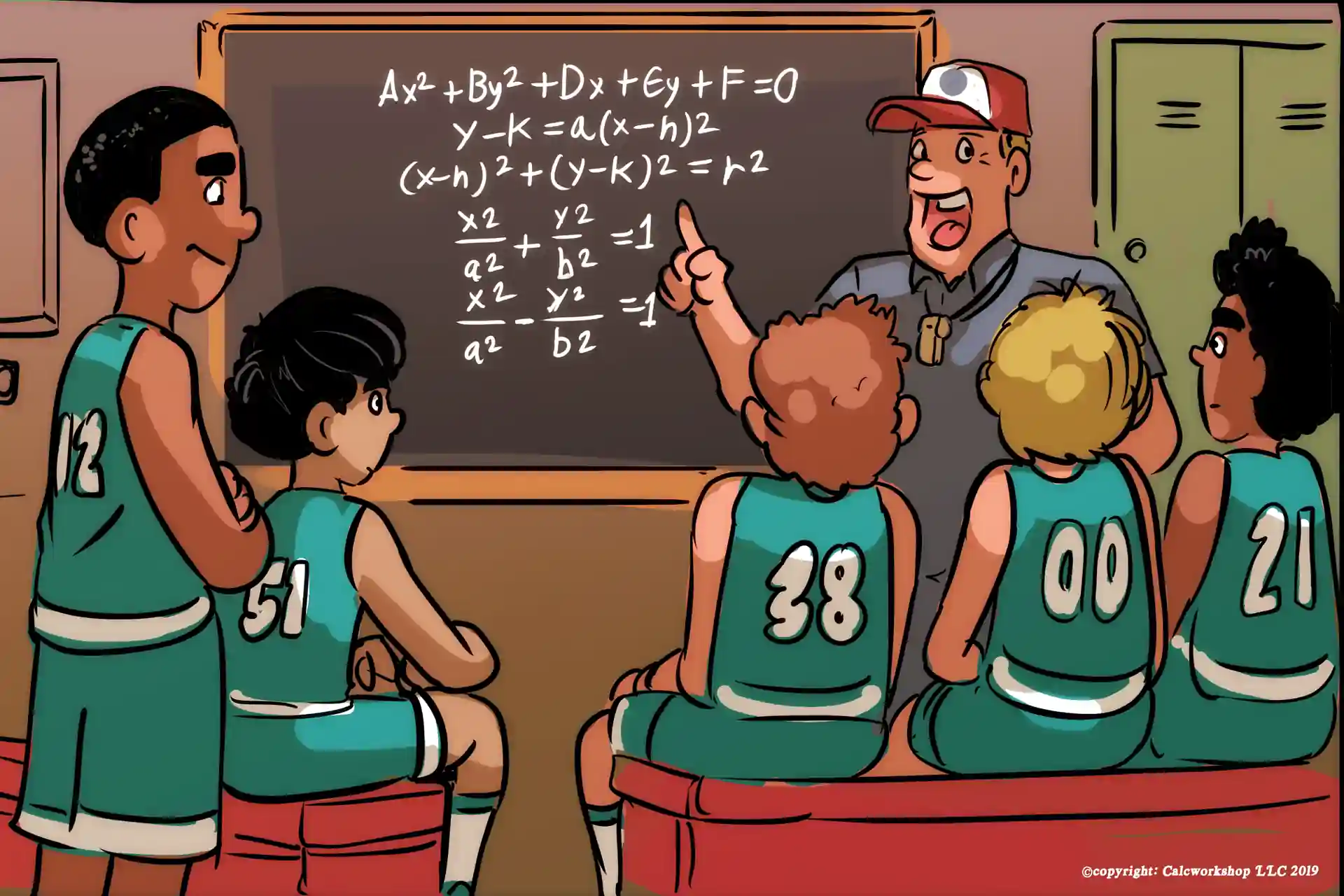
Coach Explaining Conic Sections
Start by …
- Reading your assigned textbook chapter before seeing it in class.
- Write down examples or definitions, and list any questions you don’t understand.
- Try to meet with a study group which we’ll learn about later and learn the lessons together ahead of time as well as looking over old notes so you can brush up on previously taught concepts.
Now I’m not suggesting that you do more work – but I am encouraging you to work more effectively. Even if you don’t understand everything that you read, you will undoubtedly glean valuable insight and be able to participate more in class, and you’ll find that you can handle greater levels of complexity.
Besides, if you already know what questions you have, or where you were confused in your reading, then you get the incredible opportunity to ask your instructor real-time, and not sit at home struggling and frantically searching the internet for the answers you seek.
Create more a-ha moments and reduce math anxiety with pre-knowledge!
3. Active Participation Is The Secret Sauce For Great Recall
When students participate in the learning process, whether it be through practice, review, or discussion, learning is promoted and cultivated. But you can’t rely on your instructor to facilitate critical thinking through active learning; you need to be the one who makes it happen.
Active participation can happen in two ways: public or private.
Public Participation is when you ask or answer questions, engage in class discussions, or collaborate with peers, whereas Private Participation is more of an engagement of the mind.
Students don’t always feel comfortable verbalizing their questions or answers out loud, or the classroom environment doesn’t lend itself for more public participation. This doesn’t mean active learning isn’t or shouldn’t be taking place. In fact, it’s these private moments when the student must become the architect of their own learning.
Whether or not you speak in class, the key is how you prepare before ever entering the classroom. Imagine you’re on a soccer team and today is the big game, but instead of showing up at the field in your uniform you’re wearing jeans and a t-shirt. You’re excited, and you exclaim, “put me in coach!” But you only receive gaping looks from your teammates and coach and are subsequently resigned to the bench. Why? You’re not prepared, and therefore unable to actively participate in the match.

Not Prepared For “Class”
This same principle is true for learning mathematics. You need to come to class prepared to participate.
- Read the section or chapter prior to class, so you have pre-knowledge of the material.
- Recopy your notes from previous lectures to help cement your understanding.
- Create formula sheets to help review major concepts.
Think of these things as you packing your soccer uniform – you’re getting ready for the game.
During class, take notes and either engage in public or private active learning. The more you actively participate the more adept you are at assimilating new information and will assist you in remembering the new material when it comes to test day.
Additionally, I encourage you to use unlined paper, as it will allow for more creative thinking and helps when you need to draw graphs and diagrams without the confines of those linear lines.
While active learning will look different for each student, the benefits are still the same – you are investing in your own learning and you are developing a deeper understanding of the concepts that are being presented.
4. Reduce Math Anxiety The Easy Way (Practice Problems)
Math is not a spectator’s sport. It takes practice, participation, and perseverance… the three Ps!
The only way to get better at something is to practice. A basketball player will spend hours shooting baskets just so she will expertly make the same shot in a game. This same dedication and practice are especially true when studying for a math test.

Practicing for Game Day
Your brain is like a muscle – the more you use it, the stronger it gets. And by practicing, you build what we like to call “muscle memory.”
When you practice you become:
- More adept at the steps necessary to arrive at a solution.
- Familiar with the intricacies of each question.
- The reason for each step.
- More confident in your own abilities.
In truth, your brain responds faster to the task at hand. So when it comes to taking tests you’ll be more efficient at figuring out the preferred method, and avoid scratching your head as to how you should even begin.
Additionally, the more your practice, the less anxious you become. The first time you play a hard level in a video game, your palms may sweat, and your heart rate increases. But over time, the more you play the same level, the less anxious you become. The game doesn’t seem as hard as it once did, and you’re able to complete the level with a swiftness that you didn’t have the first few times you played.
You persevered. You learned. You practiced.
When it comes to preparing for a math test, it comes down to a willingness to practice. The good thing is that practicing for a math test is easier than you may think.
Start by redoing problems you’ve already seen. This is just like replaying the same level of a video game or practicing the same jump-shot over and over again. The more you rework problems, the better you become. Besides, math is cumulative so reworking old homework problems, examples from lectures or questions from past tests and quizzes will help you fill in any gaps, increase your confidence, and help keep your brain muscle strong.
This approach is proven by several studies in Benedict Carey’s book How We Learn, where he highlights several studies which reinforce the concept of mixing up your practice problems. Since your math test is probably cumulative, make sure that your homework is too.
The hardest part of a test, isn’t necessarily solving the problem, it’s knowing which type of approach you need to take solve that problem.
So take time to do problems from previous weeks to keep your mind sharp for test day.
Then work through assigned homework problems and even attempt similar problems that weren’t assigned. Remember, tests questions have to come from somewhere, right? And what better place to find test questions than from homework problems. In fact, most teachers (myself included) love to incorporate homework problems, or very similar problems, into tests or quizzes. Therefore, practice problems (i.e., homework and lecture examples) are your best weapons for preparing for any assessment.
Math is learned by doing – you have to participate and persevere. You need to practice – period.
5. Squash Procrastination With Habit (Study Daily)
Slow and steady really does win the race.
When you study a little bit each day, your brain is able to absorb the information better and you are much more likely to remember and recall information when necessary. In fact, you will find that students who study each night have superior understanding of the subject matter and are able to relate and connect previous learning quickly.
In Cal Newport’s book, “How to Become a Straight-A Student”, he interviewed countless top scoring students who all consistently demonstrated that routinely completing their homework and studying their notes on a regular basis outperformed those who do not.
Cramming for a test may seem like a way to save time, and keep things fresh in your brain but all it really does is store information in your short-term memory, which is easily forgotten. But when you study a little bit at a time, you will find that you remember more and you will remember longer.
What you need to remember is that math is a language, and just like learning any new language you need to practice every day. Many foreign languages have specific pronunciations, idioms, and grammar rules. The only way to learn a new language is by constant practice and part of your daily routine.
Remember, your goal is to become fluent in your math course, and the best way to do that is to manage your time and be steady in your practice. So create a habit of studying daily.
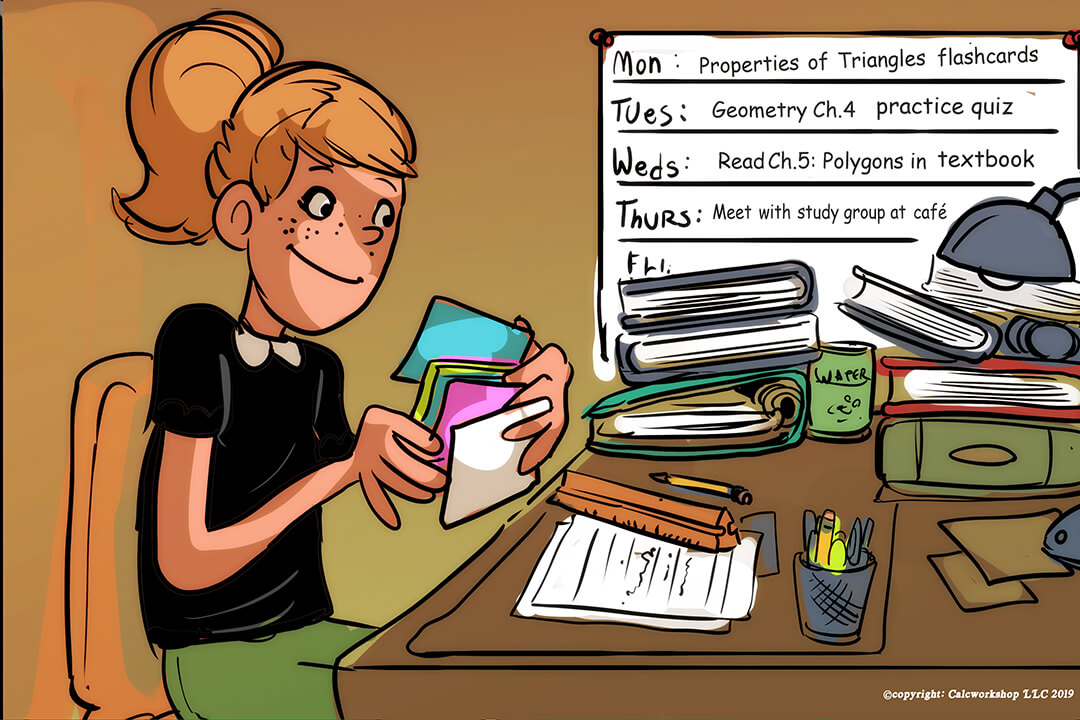
Studying Properties of Triangles
Besides, when you study a little each day, preparing for an exam won’t seem like a monumental task, because you’ve put in the time consistently.
6. Jolly Rancher Your Way To A’s
Let’s face it, studying for a math test can be hard and tedious at times, and is not always easy. So how can we ease the stress and get the most out of studying? We learn better using the Pomodoro Technique. The Pomodoro technique, named for Francesco Cirillo who used a Pomodoro (tomato) timer to train your brain to focus in small, concentrated segment. Here’s how it works:
- Choose a task – studying for a math test.
- Set the timer (Pomodoro) for 25 minutes.
- Study, without distractions for 25 minutes. You can do it – it’s only 25 minutes!
- When the timer goes off, stop and smile.
- Reward yourself. (Pop a Jolly Rancher, Go for a walk, Talk to a friend)
- Repeat.
A lot of people feel like they should be studying for hours on end, and only when they’ve suffered through all the studying and test-taking do they decide to reward themselves. But modern research has shown that studying with a built-in reward system dramatically improves the quality of studying and the attention a student gives to the task.

Studying Trig Using A Pomodoro Technique
Just knowing that in 25 minutes you can take a short break, recharge and celebrate with a reward is one powerful motivator. And the rewards don’t need to be elaborate: grab a cup of coffee, go for a walk, read a chapter in a book, take a nap, or eat a few M&Ms. Choose a reward that will help you to make it through the task, and keep you engaged.
Trust me, your brain will thank you.
7. How Does Your Study Environment Affect Your Test Scores? Or Does It?
To put it simply, studying on the couch might be comfy, but it’s not going to help your grade. The environment in which you study directly impact the quality of your study time and your ability to recall information later.
My best advice when studying for a math test is to simulate your test environment, because your brain tends to recall information in the same way in which you studied it. So, if you know that you will be taking a test in a quiet room at a small desk or table, then this is how you should study… not on your bed or on a squishy couch. The more you simulate the “testing environment,” the more comfortable your body and mind will become and the easier it will be for you to remember the information you have studied.
To make the most out of your study session, you need to familiarize yourself with your testing environment and silence all other distractions, much like it will be on test day.
First, find an area where you can study that gives you the same experience as your classroom with minimal distractions and quality lighting. Secondly, dress appropriately. This may seem silly, but when you study, you want to wear similar attire as to what you will be wearing on test day. If you normally were jeans and a t-shirt, then this is what you should wear when you’re studying – leave the sweatpants at home.
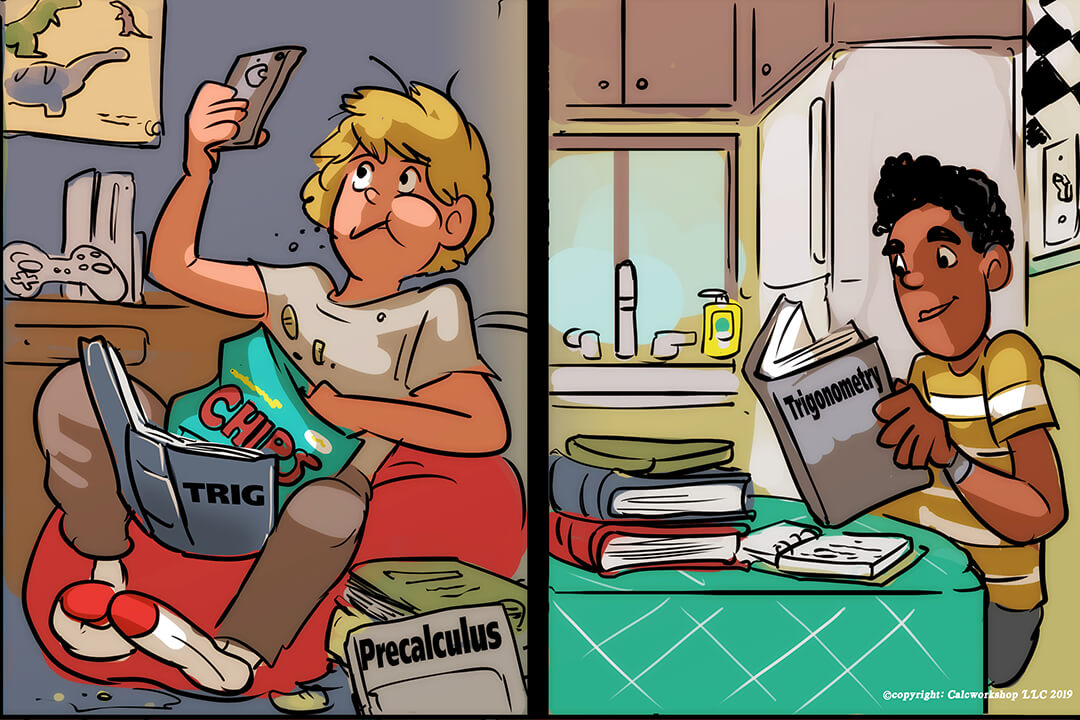
Bad vs Good Study Habits
Moreover, knowing your testing environment. Is the room cold? Hot? Will you be working at a desk or table? Is there a time limit for the test? All of these things need to be considered when you’re studying so you can simulate the conditions as much as possible.
For example, if you know that the testing room fluctuates in temperature and that your test is timed, then you need to make sure that you dress in layers and consistently study with a timer so you can practice answering questions under a time constraint.
Additionally, try to study without eating or snacking. I love to snack as much as anybody – M&M and pretzels anyone?
But you’re testing situation will not come with a bag of chips, so don’t study with them. Food will become a distraction and will negatively impact the quality of your studying. Recharging with food is a great way to reward yourself as we saw with the pomodoro technique, but do your best to not eat and study simultaneously.
And lastly, eliminate distractions like TV, Instagram, Facebook, YouTube, etc. Better yet? Turn your phone off and leave it in your bag. Again, your goal is to simulate the testing environment, so keep social media at bay during your study times and watch your retention improve.
8. Interesting Ways To Teach Others, Even If You’re Shy
Research has repeatedly shown that when students spend time teaching others, they outperform and have better retention than those who merely re-study. But the key is not so much that you’re teaching someone, because you can quite easily teach your stuffed animal or pet, it’s the act of using active recall.
The act of trying to recall information without looking at it directly is called retrieval practice.
In fact, it’s very similar to using flashcards, but it isn’t limited to just vocabulary or formulas. Try reciting your notes, listing the complete steps for solving an equation, or if you don’t feel like talking out loud, pull out a blank piece of paper and set a timer and have a brain dump by listing everything you know about a particular topic.
Additionally, this act of retrieving can also be applied to your math textbook. Try reading the chapter and then try to recall what you read. You’ll find that this simple act of “teaching” by active retrieval makes an enormous impact on your long-term achievement. And the process of vocalizing the material forces you to ensure the proper technique. Moreover, you will find that when you start saying things out loud you being to capture the emotion of the text that you simply can’t achieve when reading or reviewing material silently.

Active Recall – Teaching Stuffed Animals
And the greatest thing about this study tip is that you can “teach” anytime, anywhere.
Let’s face it; there aren’t many people who are going to jump at the chance to hear you teach them about equations, area, or the rate of change – if you find one, they’re a keeper for sure.
Therefore, you can simply talk out loud to a beloved stuffed animal. Trust me; stuffed animals make excellent listeners.
9. Let Me Show You The Power Of Study Groups
What if I told you that study groups are the special sauce that leads to success?
What you will find when you progress through your math courses from high school and college, is that due to the amount of material required for each subject, the level of outside self-study and application automatically increases. Therefore, form a study group, so you’re not left struggling on your own.
When you work with others preparing for upcoming assessments, you are forced to:
- Interact
- Participate
- Teach One Another
And this compulsory collaboration causes something amazing to happen in your brain – it actually solidifies steps and progresses firmly into your long term memory. Within a study group, you will be pushed to think through the steps and ask “why” you’re doing this.

Algebra Study Group
Working alongside a small group of your peers will give you a chance to help each other, teach one another, and remain positive and productive all while working on homework questions, review packets, or re-doing examples from notes taken in class.
Hasn’t there been times when you’ve been stuck working on something, and you just wanted to ask someone for help or clarification? Well, in a study group, there’s always someone there to answer!
Okay, so let’s talk specifics of the perfect study group!
Ideal Size Of A Study Group
While “three’s a crowd” may apply to dating, it’s actually the magic number for a study group. Having an odd number, about 3 to 5 people, actually helps in maintaining focus and keeps everyone motivated. Some people prefer to work with their friends, and this is great, but it may be advantageous to branch out a bit. I suggest you find that “high quality” person in the class and ask them to join your group. You become like the company you keep, so why not keep quality company?
Meeting Times
Additionally, ideal study groups should meet regularly for about 1 hour at a time. The more consistent your group meets, the more habit forming it becomes. Don’t just meet right before a test – get together weekly to work on homework or review previous lessons. The more regular you meet, the more comfortable you are in working together, and the more productive your group becomes.
10. Learn While Dreaming (Yes, It Does Work)
Studies have shown that the quantity and quality of sleep directly impact our:
- Focus
- Mood
- Memory
Therefore, getting adequate sleep is essential when studying mathematics. In fact, sleep plays a significant role in our ability to learn new tasks.
Without proper rest, we impede our ability to access memory and retain newly learned information. Ultimately, performance increases with adequate sleep and our judgment and disposition brighten and allow for improved learning and memory.
When we are awake and concentrating on a task, such as solving a math problem, our brain is working in what we call “Focused Mode.” This focused state is also responsible for decision making, attention, performance, and short term memory.
But contrary to popular belief, always staying focused and alert is not the best way to learn and study.
We must allow ourselves to enter a more relaxed state of thinking, to consolidate our learning and store new tasks in long-term memory. This relaxed state is called the “Diffuse Mode“, and activates connections in our brain and helps us to approach complex problems from different perspectives.
To avoid getting stuck and frustrated while studying, we must deliberately switch between focused and diffused modes, as stated in Barbara Oakley’s book A Mind for Numbers. This simple act of taking a step back and relaxing actually allows our brain to regroup and process information better.
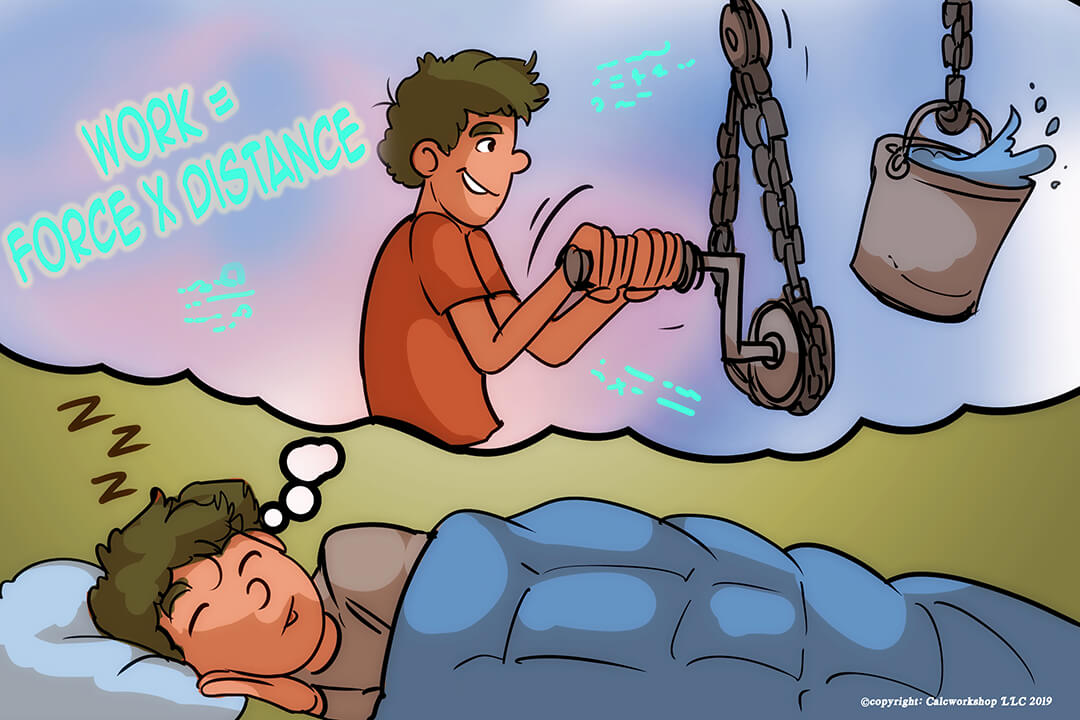
Dreaming About Math Formulas
Researchers have found that sleeping is the ultimate diffuse mode, and our subconscious continues working on a task even while we sleep. Which means that sleeping well at night directly impacts our ability to learn, perform, and recall information. Therefore, when studying for a math test, we must allow for plenty of sleep – it really will help you learn!
11. Memorization Is Hard, But It Improves Your Grade, Here’s Why…
Memorizing and understanding math facts go hand-in-hand.
Fact Fluency is the idea that students can problem solve and use a variety of tools and strategies to arrive at a solution, whereas Memorization is more synonymous with rote learning. But what is important to note is that both are vital to mathematical success.
For example, when learning your multiplication tables, you begin by learning strategies such as:
- Doubling the 2s give you the 4s.
- Knowing that the product of 8×7 can be found by first finding the product of 8×8 and subtracting one group of 8.
These fact fluency tactics help to bolster confidence and gain a deeper understanding of multiplication. But we can not be satisfied with just knowing these strategies, sometimes rapid recall is necessary and memorization must be emphasized.
Why?
Mathematics is a subject that continually builds upon itself, and being able to quickly recall math facts will greatly improve your overall performance.
In higher level mathematics courses, such as Algebra, Trigonometry, and Calculus, students must process information quickly and sequentially. Students need to recall facts while still seeing the steps and operations of the larger problem. If a student spends too much time remembering basic math facts, they are more likely to get lost in their overall calculations.
For example, when studying factoring in Algebra students must recognize factor pairs (i.e., what two numbers multiply to get the given value?). Those students who can recall their multiplication tables quickly are more confident in the task and able to progress through the topic with ease, becoming more proficient than their counterparts.
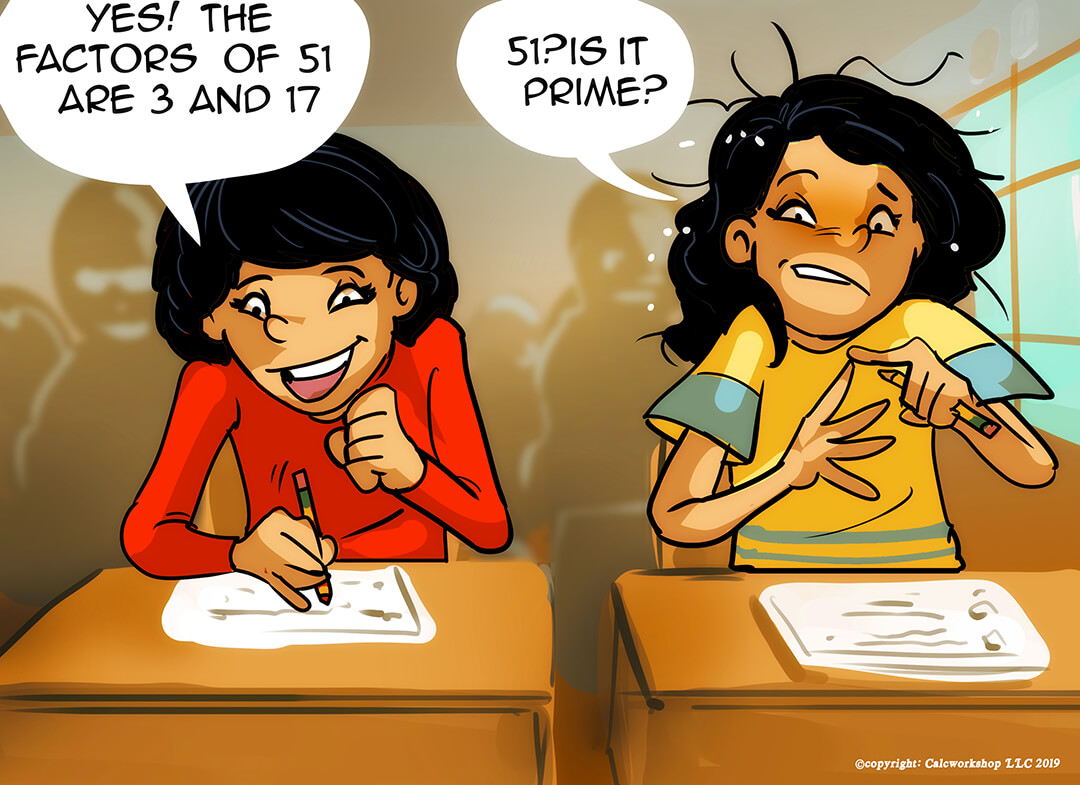
Importance Of Knowing Math Facts
Moreover, the reason why it is necessary to memorize trigonometric identities in precalculus is that they are necessary for solving complex problems involving differentiation and integration in calculus. In calculus, there are countless times when a student is asked to evaluate the trig integral and the only way to proceed is to first transform the problem using a trig identity. If those rules and formulas are not memorized, then the task of solving the given problem becomes prodigiously hard. In these instances, memorization is vital to success.
When studying for a math test, you need to have fact fluency and rapid recall through memorization. All of this comes from practice and repetition. Some students prefer flashcards either homemade or online to help them memorize:
- Formulas
- Vocabulary Terms
- Theorems
Others memorize by rewriting their notes or working through practice problems. Whichever strategies work best for you, know that knowing your math facts cold will increase your level of success.
12. Make A Study Sheet You Can Be Proud Of
When studying for a math test, you need to really engage with the material – reading over your textbook or lecture notes is not enough. One of the best ways to engage your brain and summarize the chapter and it’s key-elements is to create a study guide.
A study guide should be a combination of both textbook reading and lecture notes. Whenever something appears in both your textbook and your notes, then it’s important and will more than likely be on your exam and should be included in your study sheet.

Making A Great Study Sheet
Some students prefer outline form, whereas others will work examples or create their own quizzes, and still others will color-code their study sheets by highlighting necessary formulas or theorems.
Your study sheet will be unique and work best for you. Don’t try to copy someone else’s work – make something that works great for you.
And no matter what style you prefer, your study sheet should be a summary of the important components of the chapter.
Creating your own study guide is a fantastic way to engaging with the material, summarize important concepts, and consolidate formulas and theorems for a quick review.
13. Here’s The Easiest Way To Remember Stuff (Mnemonic Devices)
Creating stories, conjuring vivid images, or using acronyms are all excellent ways to help remember and recall large quantities of information. All of these mnemonic devices are easy to use and have been found to help students memorize information so that it sticks and can be recalled easily.
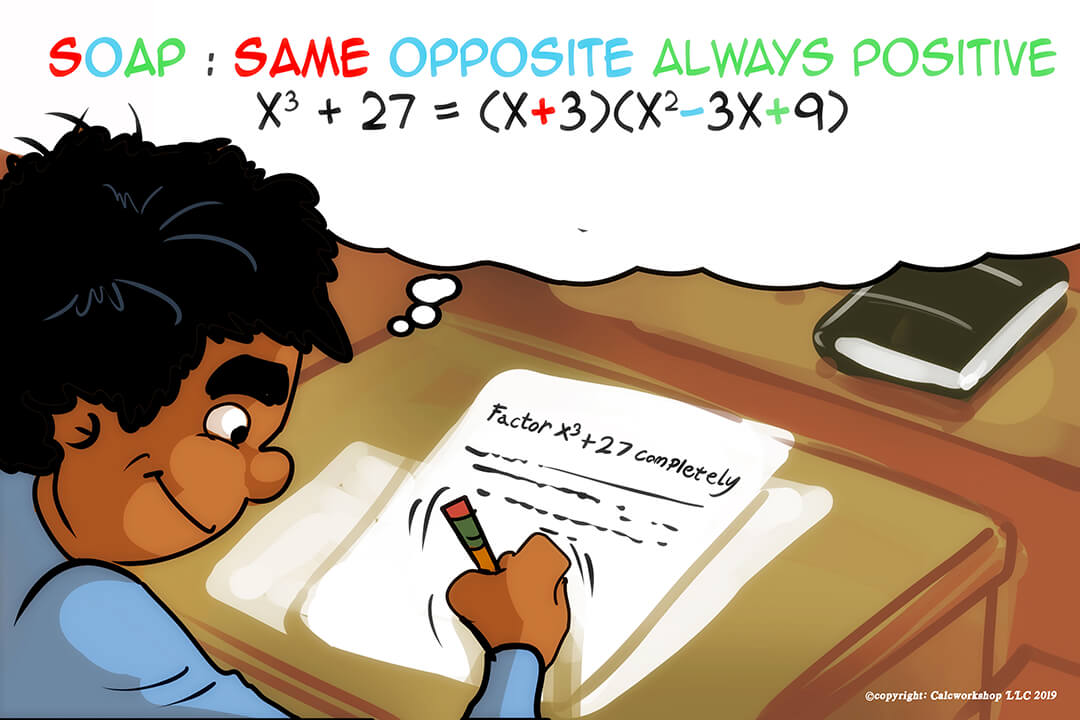
SOAP Mnemonic In Algebra
Story Method
The story method links images together in a story and helps students remember information in a sequential or logical order. Times Tale, a children’s program, uses this recall process with helping students memorize their times tables. For example, let’s say you want to remember 8×8=64? We can let Mr. and Mrs. Snowman represent the number 8, and say “Mr. and Mrs. Snowman eat 6 snow cones 4 times a day.” The story and imagery help make memorizing times tables relatable and fun.
Linking Method
The second technique is sometimes called the linking method, as it links memorable images to help with rapid recall. Have you ever noticed that you are able to remember a person’s face or can visualize a place you visited much faster than you can remember the person’s name or the names of the city?
To use the linking method, you first visualize a memorable or silly image and then think of another silly image that represents the type of information you want to remember, and then for each item you are asked to memorize you think of another new image that links it to the first. In essence, you are grouping information into images and then linking those images together.
For example, let’s say you are trying to remember the trigonometric ratios for sine, cosine, and tangent and the acronym SOH-CAH-TOA just isn’t clicking for you. We can create a mental link between each ratio by saying Oscar Had A Handful Of Apples. This silly image will help you to link or chain the ratios of Opposite, Hypotenuse, and Adjacent side lengths together and help to keep the relationships organized in your brain.
And lastly, there are acronyms that help to group or chunk information for easy recall. Some of the most classic acronyms are:
- PEMDAS for remembering the order of operations.
- SOH-CAH-TOA for recalling the trig ratios.
- ROY-G-BIV for remembering the colors of the rainbow.
They can be used to help organize information chronologically or show relatable concepts.
When creating a mnemonic device, it’s not important if it is grammatically correct or even politically correct – in fact, the more obnoxious, or dare I say inappropriate, the better chance you are to remember it. Keep in mind that this memory tool is supposed to help you, so don’t worry about what others might think and make up something that you’ll remember.
14. Mr. Calculator (Friend Or Foe?)
Don’t wait until test day to practice using technology (i.e., Mr. Calculator).
With the advancement of technology in the classroom, more and more assessments are allowing students to use graphing calculators and computers. Therefore, it is imperative that you become well versed with the tools you are expected to use on test day.
For example, every night dinner is prepared in your household. Someone has taken the ingredients and created a scrumptious meal. In fact, you’ve probably observed this cooking phenomenon every day of your life for years, and understand the process intellectually.
But if you’ve never cooked a meal before, the first time is anything but easy. Preparing, measuring, and timing are just a few aspects of cooking that take newbies by surprise and can cause panic and an ill-prepared meal.
You would never host a party or volunteer to whip up dinner for friends or family without first familiarizing yourself with the kitchen appliances, utensils, and recipe ingredients and steps, and the same thing is true for taking a math test.

Unprepared Vs. Prepared
A student may know how to row reduce a matrix by hand, but when they are asked to solve a matrix using a calculator they may stumble with finding the right buttons or commands.
Seeing someone else perform the operations isn’t enough – you need to do it yourself and practice the steps.
The last thing you want on test day is to struggle using your calculator or make mistakes simply because you didn’t practice using the tools available to you.
You don’t want to waste time on your math test struggling to find the correct buttons, so practice using calculator prior to test day. In fact, with the advancement of technology, many devices allow you to program your calculator to help solve problems faster – but to partake in this timesaving strategy you need to practice using the tools you’ve ahead of time.
15. Embrace Different Learning Styles To Get Unstuck
How, why and when we learn something has a large impact on our ability to understand new material. Sometimes just seeing the steps laid out for a problem will turn the light bulb on in our heads, whereas other times it’s a phrase or action that will create the a-ha moment.
Don’t allow yourself to be stereotyped into only one type of learning style:
- Visual (Diagrams/Maps/Charts)
- Aural (Discussions/Stories)
- Verbal (Reading/Writing)
- Kinesthetic (Hands-On Activities)
But embrace all dynamics of learning because each situation and topic will bring with it a new challenge; therefore, your learning must sometimes adapt and change for each situation.
For example, when it comes to studying for a math test, most people are visual learners and need to see the steps and process written out in detail, however, this sometimes isn’t enough to gain comprehension. Listening to an explanation, working through a problem yourself, and even explaining a new concept in your own words are all fabulous learning tools that should be employed for deeper understanding.
Moreover, there are times when you need to supplement your learning by utilizing multiple resources. Using and comparing various textbooks, especially older textbooks, may give you the extra nugget of understanding that you were missing from a class lecture. Many newer textbooks focus more on technology, whereas the older textbooks are found to be more robust in their explanations and provide many wonderful examples.

Sharing Notes To Gain A Difference Perspective
Also, many “.edu” sites have a plethora of professor notes and released exams that will complement your studies nicely. And there are even more resources online, whether it be a video or a blog post.
Everyone learns differently, and when you’re studying for a math test gaining a different perspective on the material can be a good thing.
16. What Everyone Ought To Know About Asking For Help
Embracing the struggle can be hard at first. We’ve grown up to believe that struggling is a sign of weakness; however, when you think about it, it’s really just the process of learning something new and should be rewarded. And it’s those new thought processes that require time and “struggle” to develop into new practices that help you achieve your goal. Sometimes, all we need is GRIT and one more attempt – keep at it.
Office Hours
Nonetheless, there are times when seeking assistance is the best thing we can do when studying mathematics. When looking for assistance your instructor should be your first point of contact. They are the ones leading the class, assigning homework, and writing your tests. But more importantly, you’ll be amazed at the insight and tidbits you’ll glean from meeting with your teacher outside of class time.
I know it’s hard to imagine, but teachers are people too and they have interests, quirks, and wisdom to share. Take the time to know them, and see how much they have to offer.
Besides, most instructors have designated office hours, and students need to take advantage of these opportunities. And if the times designated for outside of class help is not conducive to your schedule, then ask for additional times you can meet.
Tutoring Centers
Furthermore, most schools and universities offer peer tutoring or have designated tutoring centers where you can be matched up with a tutor. Most of these centers are free or at a minimal cost, and have shown to be very useful in working on tricky homework problems so you can be ready for your math test.

Getting Help At The Campus Tutoring Center
Online Resources
And finally, there are countless online resources available as well. Not only can you search ebooks and lecture notes, but there is a plethora of video tutorials that will help you get back on track.
Learning how to study for your math tests takes resilience and perseverance. Have the courage to keep trying and find the right resource that gets you to where you want to be.
17. GRIT
Studying for a math test takes courage and tenacity. It takes grit. Most assessments will challenge you to think “outside the box,” show process and reasoning and master a set of complicated concepts. Preparing for any test can be daunting at first.
The important thing to remember is that excelling in math is not about how smart you are or how you’ve done in the past – it’s about understanding and conquering the struggle now and believing in the power of “yet.”
Longtime math teacher, Suzanne Sutton, stated this idea perfectly when she wrote, “struggling in mathematics is not the enemy, any more than sweating is the enemy in basketball; it is part of the process and a clear sign of being in the game.” Having the courage to fail, struggle, and make mistakes is what grit is all about and it’s a necessary component for success.
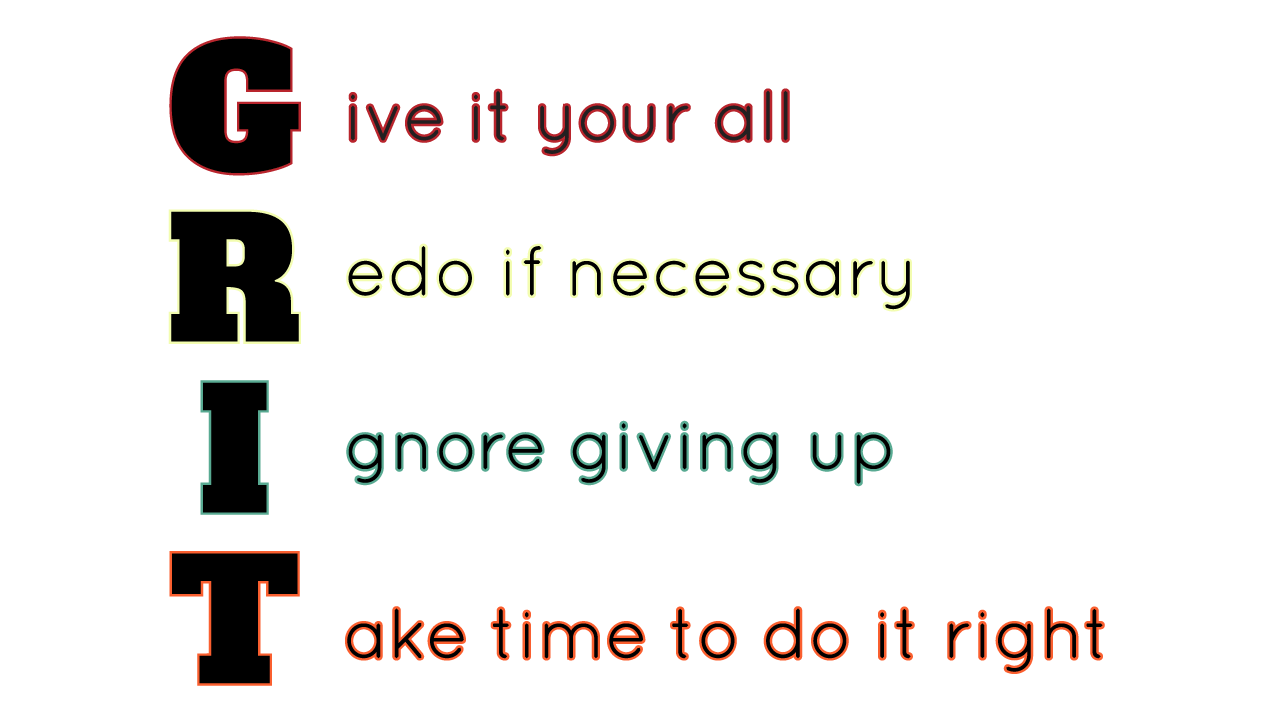
When preparing for an upcoming test, you’re going to encounter questions or concepts that are tricky and hard. But don’t give up, because true understanding takes time. Think to yourself, “I don’t understand … yet.” That small, three-letter word packs quite a punch.
Why?
Because it gives you hope, and the time you need to persevere.
Have the firmness of mind – GRIT – to struggle and not give up. You may not know…yet… but you will! Believe in yourself and in the struggle.
Get access to all the courses and over 450 HD videos with your subscription
Monthly and Yearly Plans Available
Still wondering if CalcWorkshop is right for you?
Take a Tour and find out how a membership can take the struggle out of learning math.